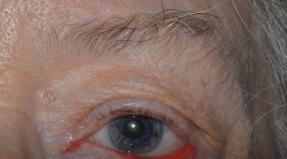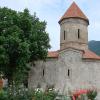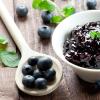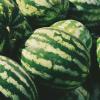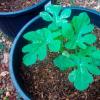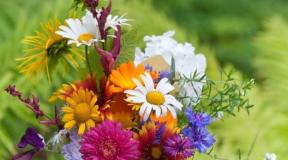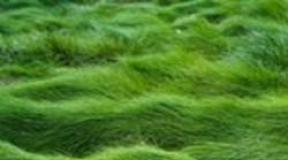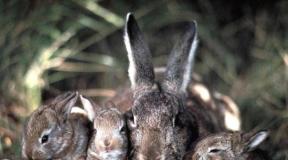Kalina sargent description. Kalina: planting, care, pruning, reproduction, use. Photo gallery: viburnum diseases
I try to create a natural type garden with a variety of varietal and wild (including rare) plants, combining beauty, usefulness and respect for the environment. perfect for this kind of garden.
I already have several growing common (Viburnum opulus) : Red bunch, Ulgen, Red coral, f. xanthocarpum, viburnum pride (Viburnum lantana) , Viburnum sargentii (Viburnum sargentii) Onondaga and a few seedlings that have grown by themselves.
Sweet-fruited varieties
Red bunch. Received at the All-Russian Research Institute of Genetics and Breeding of Fruit Plants. I.V. Michurin. The yield is high. The bush is medium tall, medium sprawling. The berries are large, maroon, spherical. The pulp is juicy, sweet and sour with a pleasant bitterness. Despite the self-fertility, if there is space, it is better to plant at least one more bush of a different variety - then the yield will be much higher.

Ulgen. Bred in NIISS them. M.A. Lisavenko. The bush is tall (up to 3.5 m) and sprawling. The fruits are intense red, rounded. The taste is mild bitter. The yield is high. Self-infertile, well pollinated by pollen of all varieties and seedlings of viburnum vulgaris. The advantages of the variety are large-fruited (0.7-0.9 g), small seeds, good quality of fresh fruits and raw jam. In dry years without irrigation, the yield drops sharply and the size of the fruit decreases.

Red coral. Created at the All-Russian Research Institute of Horticulture. I.V. Michurin. The bush is compact, medium-sized. Ripe fruits are bright red, round, large. The taste is slightly bitter with a strong aroma. High density of the brush, the yield often exceeds 10 kg per bush.
f. xanthocarp. Low lush bush with amber, almost transparent fruits. Taste and properties are similar to ordinary viburnum. Blooms in May. The leaves are yellow-green in spring, green in summer, more often in yellow tones in autumn.

I did not notice a significant difference in the taste of berries of varietal plants. The largest and most delicious berries seemed to me Ulgen , and on the brush they held tighter than other varieties. Berries varieties red coral and red bunch were slightly smaller, the bone is larger. This year, after the hurricane, more than half of the berries of the variety red bunch were on the ground.
Research by scientists and the experience of amateur gardeners show that the yield, weight of berries, and the number of fruits in an inflorescence vary greatly from year to year, depending on the weather. The yield is much greater with good care (sufficient lighting, application, regular watering and mulching, the presence of pollinators,).
Decorative varieties
. Outwardly similar to the common viburnum, but, in my opinion, much more decorative. This shrub, 2-3 m high, is very beautiful when the leaves open and during flowering. Young foliage is bronze-reddish. Large corymbose inflorescences have pinkish-white sterile flowers along the edges, and fertile burgundy in the center. Autumn leaf color is bright orange-red. The berries are red, small, bitter in taste. As with viburnum vulgaris, bark, leaves, flowers and fruits are used for medicinal purposes.

. An adult plant is a dense shrub 3-4 m high. Young branches seem to be made of light felt, shoots are scaly-pubescent. The oval leaves are green above, grayish-felt below, pleasant to the touch. The fruits, which change color from red to black when ripe, are very decorative. Almost undamaged by pests and diseases. The bark, fruits and leaves have antibacterial activity and are used for medicinal purposes.

Do you need viburnum without bitterness?
Viburnum berries are bitter due to iridoids, or bitter glycosides, biologically active substances that increase appetite and improve digestion, have diuretic, wound healing, sedative, tranquilizing, antimicrobial activity. This means that the sweet (without bitterness) viburnum that breeders seek to get will not be so useful. The bitterness in viburnum decreases after freezing or prolonged heating. But in thermally processed fruits, compared to fresh ones, the chemical composition changes significantly: the amount of pectins decreases by 21.2%, sugars - by 6.1%, and the loss of ascorbic acid reaches 94%, P-vitamin activity is lost. Therefore, it is better to freeze the viburnum before use in the freezer or collect after the onset of frost (but then the birds can get the harvest).
Pies, jam, fruit drink, kvass, jelly, jelly, marshmallow and marmalade, sauce, even a substitute (from seeds). I think that the most useful and simple thing is to freeze the berries in portioned packages or make pureed viburnum with (you can use sugar).

Recipe for pureed viburnum
Sort the berries, wash, pour over with boiling water or hold for a couple to soften the skin, rub through a sieve to a puree state. Mix the resulting mass with honey or sugar in a ratio of 1: 1 until a homogeneous consistency, arrange in jars and put in a cold place. For better dissolution of sugar, the mixture can be heated (not higher than +60 ° C). You can mix viburnum berries with or (they ripen at about the same time).
It is good to add such a blank to tea or make a vitamin drink for prevention and strengthening immunity. Kalina also has a calming, antiseptic, diuretic, astringent, hemostatic, anti-allergic effect, stabilizes blood pressure, and stimulates cardiac activity. Preparations from viburnum are used in the official and folk medicine. But remember that there are contraindications.
Shrub up to 3 m tall, branched, with straight even shoots. Young branches are yellow-brown, slightly hairy, old ones are brownish-gray, with longitudinal cracks. The leaves are opposite, deeply three-lobed, almost rounded, 5-12 cm long, 3-10 cm wide, their lobes are sharp, coarse-toothed-crenate at the edges, rounded or broadly cuneate at the base, sparsely hairy. Petiole 2-4 cm long. Inflorescences are complex corymbs, 7-11 cm across, on a common peduncle. Marginal flowers are sterile, large, white, 1.5-3 cm in diameter. The inner flowers are fertile, small, their corolla is wheel-shaped, 5-7 mm in diameter, with a cream tint. The fruits are round, red, 7-9 mm in diameter, juicy, drupe-shaped, with one stone. Seeds are flat, oval, yellowish-pink, 7-8 mm long, 6.5 mm wide, 1.5 mm thick. Weight of 1000 seeds 26-40 g.
On the Kuril Islands and Sakhalin, Viburnum Sargent blooms in June-July, bears fruit in August-September.
Viburnum Sargent in Russia is common in Eastern Siberia and the Far East: in the Amur Region, Khabarovsk (south) and Primorsky Territories, Moneron, Sakhalin and the Kuril Islands (Yuri, Kunashir, Shikotan, Iturup). The general range of the species covers China, Korea and Japan. It is confined to glades, edges of deciduous, mixed and coniferous forests, along the banks of streams, in valleys and on mountain slopes. In the south of the Russian Far East, the reserves of Sargent's viburnum are significant, but it is rare on the Kuril Islands. The species is characterized as shade-tolerant, frost-resistant and not demanding on soil richness, but sensitive to anthropogenic factors.
 Viburnum Sargent seeds with large endosperm and small undifferentiated embryo. They are characterized by a strong exogenous, morphophysiological deep type of endogenous dormancy. Seeds are recommended to be sown freshly harvested in the fall or after a long cold stratification in the spring with a seeding rate of 10 g per 1 m of length. The main reproduction is seed, but vegetative is also possible: cuttings, layering, offspring. Under the conditions of introduction (Moscow), when seeds were sown in April in a greenhouse, seedlings appeared in December after 269 days. When sown in spring with stratified seeds, seedlings appeared in May.
Viburnum Sargent seeds with large endosperm and small undifferentiated embryo. They are characterized by a strong exogenous, morphophysiological deep type of endogenous dormancy. Seeds are recommended to be sown freshly harvested in the fall or after a long cold stratification in the spring with a seeding rate of 10 g per 1 m of length. The main reproduction is seed, but vegetative is also possible: cuttings, layering, offspring. Under the conditions of introduction (Moscow), when seeds were sown in April in a greenhouse, seedlings appeared in December after 269 days. When sown in spring with stratified seeds, seedlings appeared in May.
Viburnum contains tannins, flavonoids, vitamins, organic acids, catechins, anthocyanins, phenolcarboxylic acids, fatty oils, resins, carbohydrates. According to the data available in the literature, the bark contains 0.65% tannins, catechins, 6.5% resins, formic, acetic, caprylic, oleic, linoleic, cerotic and palmitic acids (with saponification), as well as sitosterol, myricyl alcohol and viburnin. The fruits contained anthocyanins - 3-glucoside and 3-arabinosylsambubioside cyanidin, sugars (5.05%), including sucrose (0.06%), tannins and dyes (0.34%), acids, including ascorbic (up to 82 mg%), caprylic, acetic, etc., carotene (2.5 mg%), vitamin E (2 mg%), P-vitamin substances (300-500 mg%). Fatty oil (up to 21%) was isolated from the seeds, phenolcarboxylic acids, in particular chlorogenic, neochlorogenic, isochlorogenic, p-coumaric, coffee, as well as anthocyanins, coumarins and flavonoids. The roots contain arbutin, salicin, p-coumaric, coffee, neochlorogenic, gallic acids and among coumarins scopoletin, esculetin, esculin, umbelliferon.
 In Korean medicine, the bark is considered a medicinal raw material, but the fruits are also used. A decoction of the bark was used as a hypostatic in gynecological practice, the fruits - as a cardiotonic, vitamin and diuretic agent. Viburnum Sargent is included in the list of plants of oriental medicine, where its analgesic, hemostatic, antitussive properties are indicated. A decoction of the bark is taken with uterine bleeding, pain in the lower back and joints, with insomnia, as a diuretic, fruit juice - with diseases of the stomach. Kalina Sarzhent replaces the common viburnum in the Far East, therefore, they consider it possible to adequately use them in medicine. In Russia, bark preparations are used as a hemostatic agent, mainly for gynecological diseases. Fruit juice as a mild cardiotonic agent is useful for patients with heart failure. In folk medicine, root and bark preparations were used for malignant neoplasms, respiratory diseases, scrofula, diarrhea, infusion of flowers - for coughing and externally - in the treatment of a number of skin diseases.
In Korean medicine, the bark is considered a medicinal raw material, but the fruits are also used. A decoction of the bark was used as a hypostatic in gynecological practice, the fruits - as a cardiotonic, vitamin and diuretic agent. Viburnum Sargent is included in the list of plants of oriental medicine, where its analgesic, hemostatic, antitussive properties are indicated. A decoction of the bark is taken with uterine bleeding, pain in the lower back and joints, with insomnia, as a diuretic, fruit juice - with diseases of the stomach. Kalina Sarzhent replaces the common viburnum in the Far East, therefore, they consider it possible to adequately use them in medicine. In Russia, bark preparations are used as a hemostatic agent, mainly for gynecological diseases. Fruit juice as a mild cardiotonic agent is useful for patients with heart failure. In folk medicine, root and bark preparations were used for malignant neoplasms, respiratory diseases, scrofula, diarrhea, infusion of flowers - for coughing and externally - in the treatment of a number of skin diseases.
V modern classification the genus Kalina (lat. Viburnum) is a member of the Adox family (lat. Adoxaceae). According to earlier taxonomy, viburnum was part of the Honeysuckle family. There are more than 160 species in the genus, the typical representative is the common viburnum (lat. Viburnum opulus).
In translation, "viburnum" means a vine, a rod, which indicates the specific properties of the shoots of a young viburnum associated with weaving household products from them (baskets, wickerwork for glass forms, and other handicrafts). In Russian, synonyms for viburnum come from the color of ripe drupes, bright red like red-hot iron. Hence - viburnum, red-hot, kalenina, karina. In some regions, it is called bambara, bambanezha, and even unusually - pride.
Viburnum ordinary
Distribution area
The distribution area of the Adox family occupies significant areas of temperate latitudes of Eurasia and the Andes mountain range. Some species have spread in the subtropical and tropical zones of Asia and Africa. In the Russian Federation, viburnum grows everywhere. It occupies vast areas in southern Europe, the Crimea, Western and Eastern Siberia, Kazakhstan, the Caucasus, the southwest of the Baikal region and other regions, except for the northern and southeastern regions.
Under natural conditions, viburnum occupies the banks of rivers, wet places in the forest zone. It is ubiquitous on forest edges, clearings, lives with contentment among other shrubs. Kalina belongs to light-loving crops and, although it grows in the shade, it does not bear fruit. However, it does not tolerate direct sunlight, always "trying to leave" under the shade of taller trees. In country culture, it is convenient and decorative and elegant in a green fence, joint plantings with other shrubs.

Viburnum folded
Description
Representatives of the genus are mainly deciduous and evergreen shrubs or low trees. Moderately shade-tolerant and moisture-loving. They belong to the group of flowering and decorative foliage. These qualities attract the attention of landscapers involved in the decoration of landscape gardening.
Low trees, more often shrubs adorn almost every palisade in villages and villages. In the spring, from the buzzing of bees and the honey aroma, you feel dizzy, from the bitterness of autumn - tears come out, and in cold winter - the fruits seem sweeter than sweets. The root system of representatives of the genus is pivotal, branched, sufficiently developed. They form a wide crown from perennial trunks and annual young shoots. Young shoots are green, bare, ribbed over time, covered with a smooth grayish-green bark. On old branches, the bark is grayish-brown, with longitudinal cracks. In winter, it is easily distinguishable from other shrubs. bad smell when breaking wood, dense phloem and xylem tissue of a yellowish-red color.

The structure of viburnum, on the example of K. ordinary
Leaves are three to five lobed, petiolate, opposite. In some species, they can be simple with a whorled arrangement on the shoots. The leaf plate is rounded or broadly ovoid, wrinkled dark green above, shiny, entire, serrated. Below, the color is lighter, light gray shades with dense soft pubescence. Some representatives have leaves with a relatively smooth surface. The plant is decorative due to the changing color of the leaves, which by autumn acquire bright, elegant tones of orange, red, burgundy and mixed colors.
The flowers are small, white or pinkish, actinomorphic, collected in simple umbellate or complex umbellate-corymbose inflorescences, located on the tops of young branches. The calyx adheres to the ovary and consists of 5 fused sepals, along the edge of which 5 small teeth stand out. The corolla of the inner flowers is wheel-shaped, bell-shaped, slightly elongated. The marginal flowers are larger than the inner ones. In the shape of the corolla, they are slightly zygomorphic, sterile. All types of flowers are bisexual.
Flowering is long (up to 25 days), lasts from the third decade of May to mid-June. The fruits are bright red or raspberry-red, less often black or yellow drupes, round or spherical in shape with a flattened stone. The fruits are juicy, but bitter in taste, astringent, ripen in August-September. After frost, bitterness almost disappears and the taste is replaced by sweet. They can remain on the branches until spring.

Viburnum inflorescence
Popular types and forms
More than 10 species of viburnum are grown in the middle lane, including: K. forked, K. Canadian, K. dentate, K. Wright, K. proud, K. Mongolian, K. Sargent, K. plum-leaved, K. three-lobed, etc. The most popular are 5 specific forms. They are widely used for their decorative qualities and are used for landscape decoration in the form of solitary plantings, individual bushes and curtains on mowed lawns, for decorating recreation areas, discounts, mixborders.
Dwarf forms are represented by varieties with small foliage and a compact crown. For the purpose of decoration, the varieties "low" (f. Nanum) and "compact" (f. compacta) are used.
Variegated plants with leaves of white-green bright color, give an amazing decorative effect to the bushes - variegated(f. variegata, f. alba-variegata), wrinkled(f. rugosa).
The fluffy shape of the crown attracts with original leaves, dark green above, bare, shiny, in other species, when the breeze blows, they instantly change the color of the crown of the plant, giving it a grayish-green tint from the pubescence of the underside of the leaf blades: K. pride(lat. V. lantana), K. David(lat. V. davidii), K. fragrant(lat. V. odoratissimum), K. odorous(lat. V. farreri), etc.

Kalina Buldenezh
Bushes and trees belonging to the group of sterile forms of plants ("Roseum", "Mariesii", Buldenezh). The spherical crown at the time of flowering is covered with elegant inflorescences of sterile flowers that do not form fruits. It is used for decorative design of the streets of cities, villages, parks and squares, cottages and suburban households.
In summer cottages, yellow-fruited forms of shrubs are often grown. Particularly charming variety "Xanthocarpum" (Xanthocarpum). It has an attractive original golden-yellow fruit color and large yellow leaves with serrated edges.
Photogallery of species
Cultivation and care
We will tell you more about planting and caring for viburnum.
Soil requirement
In order for viburnum to please with annual flowering and harvest in open ground, it must be planted in well-lit areas. Kalina can grow successfully on infertile neutral or slightly acidic soils. Peaty, sandy and podzolic soils are not suitable for viburnum. They need to be ennobled by the additional introduction of significant amounts of humus, humus, forest or sod land.
Planting seedlings
Viburnum seedlings are planted in spring and autumn. Viburnum does not self-pollinate, so you always need to plant 2-3 trees. About a month before planting viburnum seedlings, it is necessary to add phosphorus-potassium mineral fertilizers to depleted soil, at least 30-50 g per bush, a glass of wood ash, 1/3 bucket of humus. The prepared soil mixture is combined with the soil excavated for planting the pit, and mixed thoroughly. It is important that the introduced ash does not come into contact with the roots.
The size of the planting hole should correspond to the size of the root system. The soil mixture is poured into the center of the prepared planting pit and the roots of the seedling are straightened on the tubercle. Sprinkled with soil to the middle, it is compacted around the stem and 0.5 buckets of water are poured. After soaking, the entire prepared soil mixture is again filled up. When planting viburnum, the root neck is deepened, but not more than 5 cm. After planting, the soil around the trunk is compacted and a trunk circle is formed with soil sides, the remaining 0.5 buckets of water are poured. Watering is mulched with fine mulch.

Planting viburnum in spring
Watering and fertilizing
Young seedlings are watered in the evening once every 3-4 weeks. Adult plants twice during the growing season: before flowering and in the phase of fruit growth. Young plants are fed 3-4 times during the summer:
- before bud break, nitrogen fertilizers of 40-50 g in the near-stem circle for irrigation,
- before flowering, it is better to use a glass of ash or potash (not chlorine-containing) fats in the same dose as nitrogen ones,
- during the period of fruit formation, it is necessary to feed with complete mineral fertilizer(nitrophoska, nitroammophos). After 2-3 years, mature manure and phosphorus-potassium fertilizers must be applied for digging in the fall. All top dressing is best done under watering or in the form of solutions. An adult culture is fed only in spring with a complete mineral fertilizer.

Red viburnum
pruning
Viburnum grows quickly and forms a large root shoot per year, which must be destroyed, unless otherwise provided. The growth of branches can reach 40-50 cm. Therefore, bushes and crowns of trees need constant pruning, which is divided into sanitary, shaping and rejuvenating.
Sanitary pruning is carried out periodically, in the spring before the foliage blooms. Cut out old, thickening, crooked, inward-growing perennial stems. Cut out all the shoots around the trunk. Rejuvenating pruning is carried out every 5-7 years, cutting the entire bush into 20 cm stumps. Of the new shoots, 10-15 of the strongest and most developed are left.
Forming is mainly used in the formation of the trunk of a tree and crown. To do this, within 3 years, cut out all the extra shoots, leave 1 and cut off all the side branches to the desired height. From 3-4 years old, they begin to form a crown, leaving 5-7 lateral branches above the trunk, which will become skeletal. They should be arranged in a circle at an equal distance so that the tree does not break. When forming the crown, pinch the growth point. Side shoots are starting to grow. They are also manually pinched, giving the crown a round, spherical or other shape. To maintain a beautiful shape, the crown is systematically thinned out and all shoots longer than 40 cm are pinched by hand.

Viburnum common yellow-fruited form
reproduction
Viburnum is usually propagated vegetatively and grown from seeds is much less practiced. Seeds germinate slowly. Before germination, they undergo a 1.5-2.0 year stratification. The berries are small, bitter, in small loose racemes.
Vegetative propagation of viburnum is carried out by dividing the bush, cuttings, layering, root shoots. The methods of vegetative propagation are the same as in other similar forms of plants.
Protection against diseases and pests
The crown and root system of viburnum is practically not damaged by fungal diseases. Of the pests, the most harmful are the viburnum leaf beetle (bark beetle), aphids, lilac hawk moth and barberry flower moth. To protect against pests, they use (as in other fruit and flower crops) bioinsecticide preparations, including Biostop (a novelty with a very a wide range negative effect on pests), Aktofit (akarin), Bitoxibacillin, Summer Resident, Fitoverm. Doses, timing and number of treatments, including in tank mixtures, are given in the recommendations.

viburnum bark
Beneficial features
In official medicine, for the manufacture of dosage forms, mainly the fruits and bark of red or common viburnum are used. In the treatment of certain diseases folk remedies roots and flowers are also used.
Viburnum fruits contain very important substances for human health, such as carbohydrates (9 types), pectins, organic acids, steroids, vitamins, catechins, flavonoids, sambucin and many others. Harvesting of fruits begins after their full ripening along with the stalks. For treatment use fresh and dried fruits. After drying, the stalks are removed. The use of fruits acts on the body as a tonic, diaphoretic, anti-inflammatory, laxative, wound healing, choleretic, hypotensive.
The bark is used in official medicine as a pharmaceutical raw material. It is harvested in the spring in April-May. The bark contains resins, oils, organic acids, alkaloids, saponins, triterpenoids, catechins, coumarins, flavonoids, higher fatty acids and other compounds. Preparations from the bark have effective action with diseases of the urinary-genital system, hemorrhoids, gastrointestinal tract, hypertension, dermatomycosis, diabetes, atherosclerosis, malignant tumors and other diseases. The bark is stored dry. For drying, well-ventilated dry rooms or dryers with a temperature of +50 ... +60 ° C are used.
(Viburnum sargentii Koehne). Large shrub with pseudo-dichatomous type of branching, in best conditions habitat reaches 3 meters in height. Young shoots are hairy or glabrous, but always covered with lenticels. The branches are brownish-grayish, bumpy from randomly scattered oblong or rounded lenticels. Leaf scars are stalked. Old branches and stems are covered with brown or gray cracking bark. Lives up to 40-50 years. It is fast-growing, but grows slowly under the canopy of forest stands and on shallow stony soils of mountain slopes. The wood is dense and heavy.
The kidneys are covered with two pairs of scales. The upper pair with fused edges forms a kind of case or cap. From the side of the shoot, the buds are flat, and from the outside they are convex.
The general outline of the leaf blade is ovate or rounded ovate. On young, coppice and sterile shoots, the length of the leaves reaches 12 cm, the width is 10 cm. On the other shoots, they are much smaller. The leaf blade often has three lobes and three main veins. Often there are leaves in which the width exceeds the length. The lateral blades deviate to the sides almost horizontally. The middle lobe is usually elongated. The tops of all blades are pointed into an elongated point. The base of the leaf is round, heart-shaped, wedge-shaped or truncated. blade edge
unevenly large-toothed or notched-toothed. On sterile shoots, the upper leaves often lack teeth. They are delnomarny and narrowly elliptical. Leaves are dark yellow-green above, glabrous, light green below, pubescent. The petioles are longer than those of the common viburnum, and reach 2-3.5 cm in length. They are covered with large disc-shaped glands and have two spiny stipules.
Sterile flowers with a white zygomophoric corolla 1.5-3 cm across and on long pedicels.
The free lobes of the corolla are unequal, obovate. Bisexual flowers creamy white, sessile. The obtuse lobes of the corolla are equal in length to the corolla tube. Stamens with purple anthers on filaments 1.5 times longer than the corolla tube. Rare glands are located on the stamen filaments. The stigma of the ovary is two-lobed. Inflorescence - a complex umbrella with sterile flowers along the edge up to 7-11 cm in diameter, on peduncles 2-6 cm long.
blooms Viburnum Sargent usually in May, sometimes in early June (in Khabarovsk from June 10 to June 25), within 15-20 days. The leaves bloom from the second decade of May.
The crimson autumn color of the leaves appears at the end of September and lasts until the second half of October.
The fruits are orange-red, almost spherical drupes, 7-9 mm in diameter. The taste is very similar to the fruits of viburnum ordinary. The seed is rounded, 5-7 mm in diameter, with an uneven lateral surface. The fruits ripen in early September and can hang on bushes until snow, and sometimes much longer, but most often they are quickly pecked by birds. We stretch the seed ripening period up to 25 days. Berries should be harvested between September 20 and October 30.
Within this species of viburnum, seven forms are described. Three of them differ only in the nature of the pubescence of the leaves.
1. Fluffy shape. Shrub or small tree with downy leaves and stems of inflorescences. This form has previously been described as independent species fluffy viburnum.
2. Bearded nerve form. In shrubs related to this form, the leaves are almost bare, only in the corners of the veins there are hairs / beards.
3. Intermediate form. It is isolated and described by the Japanese botanist Nakan and occupies an intermediate position between the first two. On the leaves, the hairs are located only along the main vein.
The remaining forms of viburnum Sargent are distinguished by the color and shape of the leaves and by the color of the fruits and the shape of the inflorescences; This determines their economic importance when used in green building.
4. Sterile form. It is very similar to the sterile form of viburnum vulgaris. Its inflorescences also consist of only sterile flowers and are very beautiful. It is quite rare and rarely used in landscaping.
5. Yellow-flowered form. The flowers of shrubs of this form have a yellowish corolla and therefore it also deserves wider use in planting on the streets and squares of cities and villages.
6. White-flowered form. It is characterized by flowers that have pure white petals.
7. Yellow fruit form. It is distinguished by the original yellow color of the fruit. It is decorative and deserves to be widely introduced into green building, especially in places that need autumn decoration.
Viburnum Sargent grows in the undergrowth of coniferous-broad-leaved and deciduous forests (cedar-broad-leaved, black-fir-broad-leaved, ash-broad-leaved, ash-elm, oak, etc.), as well as adjacent types of vegetation. It grows in the southern part of the Far East (Primorsky Territory, the southern part of the Khabarovsk Territory, the southern regions of the Sakhalin and Amur Regions) and in the south of Eastern Siberia (the south of the Chita Region).
All these areas are mountainous and therefore it is very difficult to draw the border of the Sargent viburnum distribution area. For example, in Primorsky Krai, where viburnum is distributed almost everywhere, in the mountains above 600 m above sea level. m.
it is not even in the very south of Primorye. Under these conditions, only the most extreme points of the northern and western limits of the distribution of Sargent's viburnum can be purely tentatively outlined.
On the east coast of Sakhalin, the boundary of the distribution of viburnum Sargent passes in the upper reaches of the river. Nabil (Kabanov, 1940), and on the west coast - south of the city of Aleksandrovsk-Sakhalinsky. In the central part of Sakhalin, on two Sakhalin Ranges (western and eastern), there is no viburnum, here the border shifts a considerable distance to the south. But between the ridges on the Tym-Poronai Plain, the Yarella border runs almost at the same latitude as on the coast. Viburnum Sargent grows on the southern Kuril Islands (Shikotan, Kunashir and Iturup).
In the mainland of the Far East, small groups of plants are found in the lower reaches of the river. Amur near Nikolaevsk-on-Amur, to the west the border goes north of Komsomolsk-on-Amur, not far from Lake Evoron and further south of the city of Chegdomyn goes into the territory of the Amur Region. Here the border passes through Abakan, r. Zeya and the upper reaches of the river. Nyukzhi, and then leaves the Far East for the Chita region. The southern border of the range of viburnum Sargent is located on the territory of the Korean Peninsula and China.
Outside the range of natural distribution, viburnum Sargent is bred almost throughout the entire territory of the European part of the USSR. The northernmost breeding points are located in Leningrad, Sverdlovsk, Solikamsk Berezniki, Ufa.
In terms of its ecological properties, viburnum Sargent is close to viburnum ordinary. It is shade-tolerant and also bears fruit well in open areas or under the canopy of sparse stands. In relation to the winter cold, it is somewhat superior to its Western relative. Kalina Sarzhent grows and develops normally in the Lower Amur and north of Komsomolsk-on-Amur, where winter frosts reach -50°C or more. It is especially well adapted to temperature fluctuations. In early spring, in the south of Primorsky Krai, an extremely unfavorable temperature regime develops, when temperature drops during the day and at night are very large and reach almost 20 ° C. Such temperature fluctuations are often the main reason for the death of many varieties of fruit trees imported from other areas. Soviet Union. Viburnum Sargent is also characterized by the resistance of the roots to winter frosts. In the southern half of Primorsky Krai, snowless winters are very common, and then the roots of woody plants are under the influence of low air temperature, which in these areas drops to -30 ° C and below.
Demanding viburnum to the richness of the soil (Solodukhin, 1962), although in some literary sources there are indications of its undemanding (Usenko, 1969). There has been some misunderstanding here. It is known that the same soils in the mountains can be infertile for tree species and fertile for shrubs. For example, a fairly common indicator of fertile soils - oxalis in the Far East is often found and grows normally in cedar forests of quality IV. On mountain slopes, soil fertility for trees is more often determined by the thickness of the root-inhabited soil layer and its skeletal structure (Solodukhin, 1965). For shrubs under these conditions, the chemistry of the soil plays an important role, since their roots usually spread in the surface horizon. Viburnum Sargent is more common on loamy and clayey, containing a significant amount of humus in the shallow part, albeit shallow, skeletal soils. It is less demanding on the moisture content in the soil than common viburnum. In places where viburnum Sargent is distributed, the lack of moisture in the soil is compensated great content it in the air, especially in coastal areas.
Unlike common viburnum, the fruits of viburnum Sargent are easier to harvest due to the confinement of its main thickets to the lower parts of mountain slopes and river valleys. There are fewer crossings and easier to find bushes. This is also evidenced by the average data on the number of fruits harvested by the picker for an 8-hour working day - 9 kg. When harvesting, the fruit clusters are cut off with secateurs and garden shears, or cut off by hand. Their collection usually begins in the third decade of September and continues for 40 days.
The collected fruits are separated from the stalks, washed and used to obtain juice. To do this, use a press, and for small batches, an ordinary juicer. Then the seeds are washed from the remaining mass and dried. The yield of pure seeds from fruits is H 12% (average about 10%). Placed for storage in any unheated warehouse, according to A. G. Emlevskaya, N. V. Krechetova, G. V. Senchukova and V. I. Shteynikova (1964), the seeds remain viable for 5 years. Seed germination usually ranges from 70 to 80%. Seeds of viburnum Sargent are larger than seeds of common viburnum, average weight is 1000 pcs. equal to 33 g. The duration of stratification is 4-5 months. Usually, the seeds are laid in stratification immediately after harvesting the fruits. If they begin to germinate before they can be sown, they are kept under the snow.
Viburnum Sargent in the Far East began to grow a long time ago and on large areas. Viburnum seeds were easier and easier to harvest than the seeds of many other species, especially conifers. Her bushes grew in river valleys, near roads and settlements, and sometimes near the nursery. Kalina often died off due to inconsistencies in soil and soil conditions (lack of moisture and nutrients). Now viburnum Sargent is bred mainly for green building.
Viburnum Sargent gives abundant stump shoots and rarely root offspring. It is propagated by seeds, layering, winter and summer cuttings. When growing seedlings, 240 seeds, or 8 g of seeds of the 1st grade, are sown per 1 m of the sowing line. Seeding depth 3 cm. The best sowing time is early spring. Row placement is common for deciduous shrubs. From 1 ha, 600-700 thousand seedlings are obtained.
The genus includes 200 species distributed in the subtropical and temperate zones of Eurasia.
Description of viburnum
growing viburnum in the form of deciduous or evergreen shrubs, sometimes small trees. Most of the species are shade-tolerant and moisture-loving. Absolutely all species have an opposite, sometimes whorled arrangement of leaves. Red or black fruits are mostly edible. Viburnum breeds cuttings, seeds, layering. The inhabitants of central Russia have a sign of viburnum due to the wide distribution - viburnum vulgaris.
In the wild, it can be found in almost every forest - in a clearing, edge, clearing.
Viburnums are very decorative. Most begin to bloom in May, ending the spring riot of flowers with their pinkish, white or yellowish inflorescences. Flowering, sometimes stretching for three weeks. All viburnums are excellent honey plants.
Viburnum and fruits are famous. Berries acquire coloring in August. They look great against the background of a green crown, delight the eyes all autumn and adorn the bushes even in winter. In some species, the fruits are pinkish-orange or red. Other types of viburnum give black berries with a blue or bluish bloom. But there is such a viburnum that has fruits of 2 colors: mature ones are black, and others, immature, are red.
Types and varieties of viburnum
Some species of viburnum have decorative forms that differ from their ancestors in special features. appearance. The most famous cultivar of viburnum vulgaris is Buldenezh.
Viburnum red or common
It grows in the forest and forest-steppe zone of almost all of Europe.
Shrub or tree 4 m high. The trunk of the bush is covered with fissured bark. The leaves of common viburnum are large, 5-lobed, light green in the spring season, simply green in summer, reddish in autumn.
Barren white flowers bloom a few days earlier than fertile viburnums, decorating the shrub for 15 days. Fruits - red drupes of rounded shape, with yellow flesh, edible, look cute against the background of greenery.

Has decorative forms:
Viburnum ordinary"Nanum" ("Nanum") is a dwarf form (1m) with small leaves. Vegetates from April to early October. Growth is slow. It freezes a little in winter.
Viburnum ordinary"Roseum" ("Roseum") - the most common, it is also called "Bulde-nezh". The height of the bush is 2 m, the tree is 4 m. The crown of the common viburnum Buldenezh is wide-spreading. Globular inflorescences consist of barren flowers, first olive, then white, resembling snowballs.

When flowering, the flowers of viburnum Buldenezh turn pink. During flowering, which lasts 35 days, the shrub is decorative both in group and in single planting. It looks especially impressive near the water and in standard form.
Viburnum ordinary"Compactum" ("Compactum"), Bush up to 2 m high. Blossoms in June.

Flowers viburnum ordinary "Compactum", marginal white, median small, bisexual, pinkish or white. The fruits of the common viburnum "Compactum" are bright red.
Viburnum ordinary"Aureum" ("Aureum"). The bush is compact in shape, 2 m high. The foliage is yellow, in summer they turn green. Her flowers are white. The fruits of the common viburnum "Aureum" are of a beautiful red color. It looks beautiful in a small penumbra, especially in sunny hot summers. May freeze.
Kalina Sargent
Under natural conditions, it is distributed in the Far East, Eastern Siberia, Sakhalin, Korea, and Japan. Viburnum Sargent is common in the European part of Russia, in Altai, the Urals, where it is found along forest edges, clearings, among thickets near water.

Viburnum Sargent has a spreading bush and leaves with long petioles and a central vein. Flowering begins at the end of May. Barren flowers up to 3 cm in diameter, flowers have purple, sometimes yellow, anthers. In early October, spherical bright red fruits ripen.
Shade-tolerant, winter-hardy. Viburnum Sargent is a good ornamental shrub, especially spectacular during flowering and fruiting, in solitary, along the banks of reservoirs.
Kalina pride
It is a well-known viburnum with black fruits, which are also edible. Viburnum pride is widespread in Asia Minor, Central and Southern Europe, and in the North Caucasus.
Viburnum pride has a completely different look compared to red viburnum. Shrub 5 m high. The crown is compact, dense, 2.5 m in diameter.
Viburnum pride - one of the most beautiful ornamental shrubs, has long been used in landscaping parks and gardens. Undemanding to soils, frost-resistant, shade-tolerant, drought-resistant, retains pink-red leaves and black fruits until winter. Perfectly propagated by seeds.

This type of viburnum is one of the most beautiful ornamental shrubs, elegant during flowering, during fruit ripening and in the autumn season - brightly colored foliage. It goes well with linden and oak.
Viburnum pride has decorative forms: variegated - with yellow-variegated foliage; and wrinkled - with larger inflorescences and more wrinkled leaves.
Kalina pride "Aureum". Bush 3 m high, with oval leaves. The leaves are golden above, silver-felt below.
Viburnum pride "Aureo-variegatum". The leaves of this viburnum with yellow stripes and spots. Flowering occurs in May, may sometimes bear fruit.
Viburnum black
It grows in the south of the Khabarovsk and Primorsky Territories. It grows in coniferous-deciduous forests.
Strongly branching, sprawling bush about 3 m in height, sometimes a small tree with an openwork crown, a grayish trunk and light, bare, yellow-gray branches. The leaves are elliptical, sharp at the top, dark green above; yellow-white, inconspicuous flowers are collected in corymbose inflorescences.

The fruits of viburnum black with a shiny, black skin and sweet pulp, edible.
Viburnum black is photophilous and demanding on the soil. It tolerates transplant very well. Decorative all season, but especially in autumn.
Protection from pests and diseases: often viburnum is affected by viburnum bark beetle, which eats all the foliage, leaving only veins from them. To combat it, you can treat it with 0.2% chlorophos.
Decorative forms of viburnum best propagated by cuttings. Their rooting rate is very high.

All viburnums are decorative, some have a variety of decorative forms. Viburnums are very spectacular against the background of lindens, birches, maples, firs and mountain ash. Viburnums in the garden are not only beautiful, but also useful, medicinal and edible plants.


